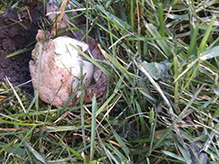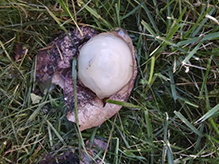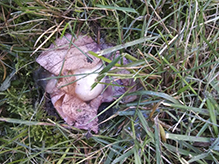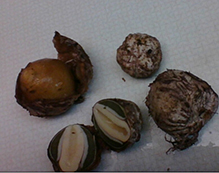Ravenel’s Stinkhorn
(Phallus ravenelii)
Conservation • Description • Habitat • Ecology • Distribution • Taxonomy
|
|
||||||||||||||
Description |
Ravenel’s Stinkhorn is a common and widespread mushroom in gardens, lawns, meadows, cultivated areas, and woodlands of eastern North America. It is found from August through October, singly or in clusters, on the ground or on well rotted stumps, logs, wood chips, or sawdust. It is saprobic, obtaining its nutrients from decaying wood. The fruiting body at first is white to pinkish, egg-shaped, up to 2⅜″ tall, and resembles a puffball at least partially submerged in the ground. It is attached to the ground or other substrate by thread-like, branching, similarly colored strands (mycelium). Inside the “egg” there is a gelatinous layer and a green spore mass (gleba), and all of the fully-formed parts of the mature stinkhorn. When conditions are right the “egg” ruptures and expands rapidly, sometimes in as little as one hour, producing a 4″ to 6″ tall, distinctly phallic structure with a stalk and thimble-like head. The rapid expansion is possible because all of the parts are fully formed and compressed inside the “egg”, and because the individual cells elongate, rather than new cells being produced. As the stinkhorn expands the gelatinous layer mixes with the spore mass producing a shiny, putrid slime that covers the cap. The foul-smelling slime is irresistible to flies, which feed on it, lay their eggs in it, and transfer spores when they fly to other stinkhorns. The stalk is spike-like, hollow, spongy, fragile, 4″ to 6″ tall, and ⅝″ to 13 ⁄16″ thick. It is usually entirely white but may be tinged yellowish or pinkish toward the base. At the base of the stalk the remnants of the ruptured “egg” (volva) is white, sometimes tinged with pink. The cap is thimble-like, ⅝″ to 19 ⁄16″ in diameter and 19 ⁄16″ to 1¾″ in height. There is a white, circular opening at the top where it attaches to the stalk. There are sometimes remnants of a membranous veil attached to the bottom of the cap. At first, the cap is covered with a thick, slimy or gluey, shiny, olive-brown to dark brown, spore-bearing mass (gleba). The gleba has a strong, putrid odor, repulsive to humans but irresistible to flies. When it is carried off by flies and/or washed off by rain it reveals a dark. granular, smooth or slightly wrinkled, but not deeply pitted and ridged surface. There are no gills. All stinkhorns are edible but the slimy consistency inside the “egg” and the putrid odor of the mature specimen are enough to dissuade most from collecting it for the table. |
Similar Species |
Common Stinkhorn (Phallus impudicus) cap is deeply pitted and ridged (reticulate) beneath the slime. |
Habitat and Hosts |
Gardens, lawns, meadows, cultivated areas, and woodlands. |
Ecology |
Season |
August through October |
Distribution |
||
|
Sources |
|
| 9/5/2024 | ||
Occurrence |
||
Widespread; more common in eastern United States |
||
Taxonomy |
|
Kingdom |
Fungi (Fungi) |
Subkingdom |
Dikarya |
Phylum |
Basidiomycota (Basidiomycete Fungi) |
Subphylum |
Agaricomycotina (Higher Basidiomycetes) |
Class |
Agaricomycetes (Mushrooms, Bracket Fungi, Puffballs, and Allies) |
Subclass |
Phallomycetidae |
Order |
Phallales (stinkhorns and allies) |
Family |
Phallaceae (stinkhorns) |
Genus |
Phallus |
Subordinate Taxa |
|
|
|
Synonyms |
|
Aedycia ravenelii Ithyphallus ravenelii |
|
Common Names |
|
Ravenel’s Stinkhorn |
|
Glossary
Gleba
The inner spore-bearing mass of puffballs, earthstars, and stinkhorns. The term is also used to refer to the spore-bearing slime covering the head of a stinkhorn.
Mycelium
The vegetative part of a fungus; consisting of a mass of branching, thread-like hyphae, through which a fungus absorbs nutrients from its environment; and excluding the fruiting, reproductive structure.
Saprobic
A term often used for saprotrophic fungi. Referring to fungi that obtain their nutrients from decayed organic matter.
Volva
Also called cup. A cup-like covering at the base of a mushroom stem, sometimes buried. In Amanita, Volvariella, and some other mushrooms, it is the remnants of the universal veil ruptured by the mushroom pushing through. In Phallales it is the remnants of the ruptured peridium.
Visitor Photos |
||
Share your photo of this fungus. |
||
This button not working for you? |
||
Ingrid Carlson |
||
I have a curiosity. My students found some funky underground mushrooms (truffles or false truffles?) under the wood chips around the play equipment today. They are pretty cool – the have a peel that has a slime layer beneath it. The centre is hard and yellow. We haven’t cut into one yet but plan to. We live in Fort Frances – which is just North of and across the border from International Falls Minnesota. If I am able to attach a picture or two, is there someone there who might be able to identify them for us. Mushrooms are a special interest of mine and it would be fun to explore these funky new ones with my students. |
||
William Tindell |
 |
I found a couple of these fungus in the woods by my home. Any idea what they are? |
Brian |
 |
Two eggs and two stinkhorns growing in garden mulch |
Luciearl |
||
 |
 |
|
 |
||
Kirk Nelson |
 |
MinnesotaSeasons.com Photos |
||

Slideshows |
|

Visitor Videos |
||
Share your video of this fungus. |
||
This button not working for you? |
||
|
Other Videos |
||
Phallus ravenelii, stinkhorn mushroom |
About
Published on Jul 27, 2012 This is a 30 hour time lapse of a trio of autumnal stinkhorn mushrooms, Phallus ravenelii. Images were taken at 5 minute intervals. |
Stinkhorn Growth (Phallus Ravenelii) |
About
Published on Oct 2, 2014 Phallus Ravenelii 351 Images over 4 hours More info: http://goo.gl/5GruZ1 |
Dictyophora duplicata and Phallus ravenelii, stinkhorn mushrooms |
About
Published on Jul 27, 2012 This is a 3 day, 5 hour time lapse movie of the stinkhorn mushrooms Dictyophora duplicata (left) and Phallus ravenelii (right) growing and senescing. Towards the end of the movie, note the fly that is attracted to the fetid carrionlike odor of the stinkhorns. It'll pick up sticky spores on it's tarsi and spread them to new locales. Images were taken at 5 minute intervals. The less-than-straight growth of the stickhorns is the results of digging them up from the mulch where they were growing to move them to the photo studio. |

Visitor Sightings |
||
Report a sighting of this fungus. |
||
This button not working for you? |
||
| Brian 8/24/2022 |
Location: Anoka County Two eggs and two stinkhorns growing in garden mulch |
 |
| Luciearl 9/26/2021 |
Location: Maplewood, Ramsey County |
 |
Charlene |
Location: St. Paul, MN They have grown 2 years in the mulch around our house. I decided to identify it this year because the smell is unbelievable. |
|
| Matt 9/1/2019 |
Location: Walker, MN Stinky! |
|
April Horne |
Location: east of Rochester, Mn |
|
| Kirk Nelson 10/16/2016 |
Location: Lebanon Hills Regional Park |
 |
MinnesotaSeasons.com Sightings |
||
|

Created: 10/29/2016 Last Updated: © MinnesotaSeasons.com. All rights reserved. |


